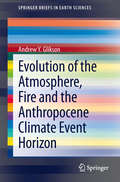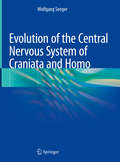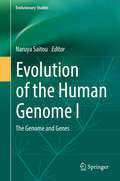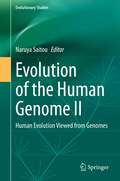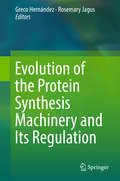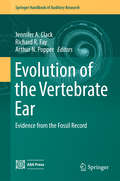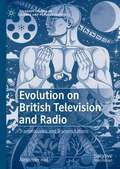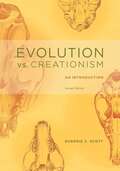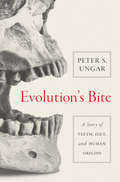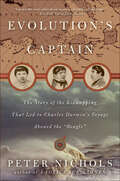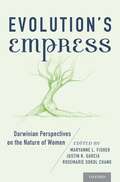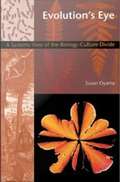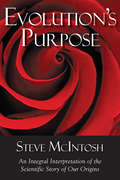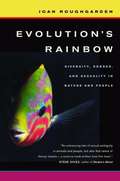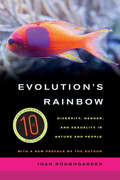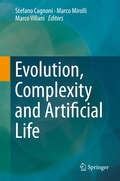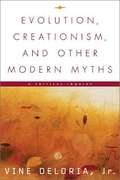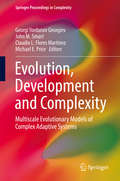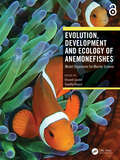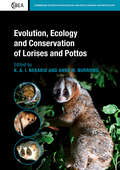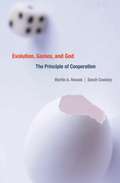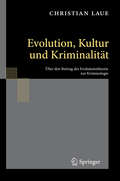- Table View
- List View
Evolution of the Atmosphere, Fire and the Anthropocene Climate Event Horizon
by Andrew Y. GliksonUnique among all creatures, further to the increase in its cranial volume from Australopithecus to Homo sapiens, the use of tools and cultural and scientific creativity, the genus Homo is distinguished by the mastery of fire, which since about two million years ago has become its blueprint. Through the Holocene and culminating in the Anthropocene, the burning of much of the terrestrial vegetation, excavation and combustion of fossil carbon from up to 420 million years-old biospheres, are leading to a global oxidation event on a geological scale, a rise in entropy in nature and the sixth mass extinction of species.
Evolution of the Central Nervous System of Craniata and Homo
by Wolfgang SeegerThe main focus of this book is on providing students, neurosurgery trainees, certified neurosurgeons and colleagues in neighbouring disciplines essential information on the evolution of the central nervous system (CNS) of craniata and homo. Therefore the book is divided in three parts: Part I is describing the evolution of CNS of craniata (starting 800 million of years ago). Part II is explaining in detail the exceptional position of the human encephalon. Part III is discussing maturity and immaturity of all parts of CNS of craniatas and the consequences concerning further development of brain structure and psychological functions. In all parts anatomical fundamentals are presented in the form of didactic and self-explanatory illustrations.
Evolution of the House Mouse
by Milo Macholán Stuart J. E. Baird Pavel Munclinger Jaroslav PiálekThe house mouse is the source of almost all genetic variation in laboratory mice; its genome was sequenced alongside that of humans, and it has become the model for mammalian speciation. Featuring contributions from leaders in the field, this volume provides the evolutionary context necessary to interpret these patterns and processes in the age of genomics. The topics reviewed include mouse phylogeny, phylogeography, origins of commensalism, adaptation, and dynamics of secondary contacts between subspecies. Explorations of mouse behaviour cover the nature of chemical and ultrasonic signalling, recognition, and social environment. The importance of the mouse as an evolutionary model is highlighted in reviews of the first described example of meiotic drive (t-haplotype) and the first identified mammalian speciation gene (Prdm9). This detailed overview of house mouse evolution is a valuable resource for researchers of mouse biology as well as those interested in mouse genetics, evolutionary biology, behaviour, parasitology, and archaeozoology.
Evolution of the Human Genome I
by Naruya SaitouThis book reviews the human genome from an evolutionary perspective. No such book has ever been published before, although there are many books on human genomes. There are two parts in this book: Overview of the Human Genome (Part I) and The Human Genome Viewed through Genes (Part II). In Part I, after a brief review of human evolution and the human genome (by Naruya Saitou), chapters on rubbish or junk DNA (by Dan Graur), GC content heterogeneity (by Satoshi Oota), protein coding and RNA coding genes (by Tadashi Imanishi), duplicated genes (by Takashi Kitano), recombinations (by Montanucci and Bertranpetit), and copy number variations including microsatellites (by Naoko Takezaki) are discussed. Readers can obtain various new insights on the human genome from this part. In Part II, genes in X and Y chromosomes (by Yoko Satta and others), HLA genes (by Timothy A. Jinam), opsin genes (by Shoji Kawamura and Amanda D. Melin), genes related to phenotypic variations (by Ryosuke Kimura), transcription factors (by Mahoko Takahashi and So Nakagawa), diabetes-related genes (by Ituro Inoue), disease genes in general (by Ituro Inoue and Hirofumi Nakaoka), and microbial genomes (by Chaochun Wei) are discussed. The human genome sequences were determined in 2004, and after more than 10 years we are now beginning to understand the human genome from an evolutionary point of view. This book furnishes readers with a good summary of current research in the field.
Evolution of the Human Genome II: Human Evolution Viewed from Genomes (Evolutionary Studies)
by Naruya SaitouThis two-volume set provides a general overview of the evolution of the human genome; The first volume overviews the human genome with descriptions of important gene groups. This second volume provides up-to-date, concise yet ample knowledge on the genome evolution of modern humans. It comprises twelve chapters divided into two parts discussing “Non-neutral Evolution on Human Genes” (Part I) and “Evolution of Modern Human Populations” (Part II.) The most significant feature of this book is the continent-wise discussion of modern human dispersal using human genomic data in Part II. Recent results such as introgression of paleogenomes to modern humans, new methods such as computer simulation of global human dispersals, and new information on genes for humanness will be of particular interest to the readers. Since the euchromatin regions of the human genome was sequenced in 2003, a huge number of research papers were published on modern human evolution for a variety of populations. It is now time to summarize these achievements. This book stands out as the most comprehensive book on the modern human evolution, focusing on genomic points of view with a broad scope. Primary target audiences are researchers and graduate students in evolutionary biology.
Evolution of the Insects
by David GrimaldiInsects are the most diverse group of organisms in the 3 billion-year history of life on Earth, and the most ecologically dominant animals on land. This book chronicles for the first time the complete evolutionary history of insects: their living diversity, relationships and 400 million years of fossils. Whereas other volumes have focused on either living species or fossils, this is the first comprehensive synthesis of all aspects of insect evolution. The book is illustrated with 955 photo- and electronmicrographs, drawings, diagrams, and field photos, many in full colour and virtually all of them original. The book will appeal to anyone engaged with insect diversity: professional entomologists and students, insect and fossil collectors, and naturalists.
Evolution of the Protein Synthesis Machinery and Its Regulation
by Greco Hernández Rosemary JagusThis book provides insight into the evolution of the translation process and machinery from a modern perspective. Written by leading experts in molecular biology, this text looks into the origins and evolution of the protein synthetic machinery.
Evolution of the Vertebrate Ear
by Jennifer A. Clack Arthur N. Popper Richard R FayThe evolution of vertebrate hearing is of considerable interest in the hearing community. However, there has never been a volume that has focused on the paleontological evidence for the evolution of hearing and the ear, especially from the perspective of some of the leading paleontologists and evolutionary biologists in the world. Thus, this volume is totally unique, and takes a perspective that has never been taken before. It brings to the fore some of the most recent discoveries among fossil taxa, which have demonstrated the sort of detailed information that can be derived from the fossil record, illuminating the evolutionary pathways this sensory system has taken and the diversity it had achieved.
Evolution on British Television and Radio: Transmissions and Transmutations (Palgrave Studies in Science and Popular Culture)
by Alexander HallThis book charts the history of how biological evolution has been depicted on British television and radio, from the first radio broadcast on evolution in 1925 through to the 150th anniversary of Charles Darwin’s Origin of the Species in 2009. Going beyond science documentaries, the chapters deal with a broad range of broadcasting content to explore evolutionary themes in radio dramas, educational content, and science fiction shows like Doctor Who. The book makes the case that the dominant use in science broadcasting of the ‘evolutionary epic’, a narrative based on a progressive vision of scientific endeavour, is part of the wider development of a standardised way of speaking about science in society during the 20th century. In covering the diverse range of approaches to depicting evolution used in British productions, the book demonstrates how their success had a global influence on the genres and formats of science broadcasting used today.
Evolution vs. Creationism: An Introduction
by Eugenie C. ScottMore than eighty years after the Scopes trial, the debate over teaching evolution continues in spite of the emptiness of the creationist positions. This accessible resource, now completely revised and updated, provides an essential introduction to the ongoing dispute’s many facets―the scientific evidence for evolution, the legal and educational basis for its teaching, and the various religious points of view―as well as a concise history of the evolution-creationism controversy. This second edition also contains a discussion of the legal history, updated to include the seminal case of Kitzmiller v. Dover as well as a new chapter on public opinion and media coverage.
Evolution's Bite: A Story of Teeth, Diet, and Human Origins
by Peter S. UngarWhat teeth can teach us about the evolution of the human speciesWhether we realize it or not, we carry in our mouths the legacy of our evolution. Our teeth are like living fossils that can be studied and compared to those of our ancestors to teach us how we became human. In Evolution's Bite, noted paleoanthropologist Peter Ungar brings together for the first time cutting-edge advances in understanding human evolution and climate change with new approaches to uncovering dietary clues from fossil teeth to present a remarkable investigation into the ways that teeth—their shape, chemistry, and wear—reveal how we came to be. Ungar describes how a tooth's "foodprints"—distinctive patterns of microscopic wear and tear—provide telltale details about what an animal actually ate in the past. These clues, combined with groundbreaking research in paleoclimatology, demonstrate how a changing climate altered the food options available to our ancestors, what Ungar calls the biospheric buffet. When diets change, species change, and Ungar traces how diet and an unpredictable climate determined who among our ancestors was winnowed out and who survived, as well as why we transitioned from the role of forager to farmer. By sifting through the evidence—and the scars on our teeth—Ungar makes the important case for what might or might not be the most natural diet for humans.Traveling the four corners of the globe and combining scientific breakthroughs with vivid narrative, Evolution's Bite presents a unique dental perspective on our astonishing human development.
Evolution's Captain: The Story of the Kidnapping That Led to Charles Darwin's Voyage Aboard the "Beagle"
by Peter NicholsThe story of a visionary but now forgotten English naval officer and the events without which the name Charles Darwin would be unknown to us today.Captain Robert FitzRoy’s first voyage aboard the HMS Beagle had concluded with the kidnapping of four “savages” from Tierra del Fuego. But when his plan to bring them back to England to civilize them as Christian gentlefolk backfired, the second and most famous voyage of the Beagle was born. In naval terms, this second voyage—with twenty-two-year-old Charles Darwin in tow—was a stunning scientific success. But FitzRoy, a fanatical Christian was horrified by the heretical theories Darwin began to develop. As these ideas came to influence the most profound levels of religious and scientific thinking in the nineteenth century, FitzRoy’s knowledge that he had provided Darwin the vehicle for his sacrilegious ideas propelled him irrevocably toward suicide.Praise for Evolution’s Captain“A powerful story played out against a beguiling landscape. . . . Nichols has a finely tuned sense of history.” —New York Times Book Review“A fascinating account. . . . A finely researched, engaging book.” —Atlanta Journal-Constitution“It’ll prove hard not to share [Nichols’s] fascination with how FitzRoy’s naval career inadvertently set off a scientific controversy still flaring to this day.” —Publishers Weekly
Evolution's Empress: Darwinian Perspectives On The Nature Of Women
by Maryanne Fisher Justin Garcia Rosemarie Chang Sarah HrdyOver the last decade, there has been increasing debate as to whether feminism and evolutionary psychology can co-exist. Such debates often conclude with a resounding "no," often on the grounds that the former is a political movement while the latter is a field of scientific inquiry. In the midst of these debates, there has been growing dissatisfaction within the field of evolutionary psychology about the way the discipline (and others) have repeatedly shown women to be in passive roles when it comes to survival and reproduction. Evolutionary behavioral research has made significant strides in the past few decades, but continues to take for granted many theoretical assumption that are perhaps, in light of the most recent evidence, misguided. As a result, the research community has missed important areas of research, and in some cases, will likely come to inaccurate conclusions based on existing dogma, rather than rigorous, theoretically driven research. Bias in the field of evolutionary psychology echoes the complaints against the political movement attached to academic feminisms. This is an intellectual squabble where much is at stake, including a fundamental understanding of the evolutionary significance of women's roles in culture, mothering, reproductive health and physiology, mating, female alliances, female aggression, and female intrasexual competition. Evolution's Empress identifies women as active agents within the evolutionary process. The chapters in this volume focus on topics as diverse as female social interactions, mate competition and mating strategies, motherhood, women's health, sex differences in communication and motivation, sex discrimination, and women in literature. The volume editors bring together a diverse range of perspectives to demonstrate ways in which evolutionary approaches to human behavior have thus far been too limited. By reconsidering the role of women in evolution, this volume furthers the goal of generating dialogue between the realms of women's studies and evolutionary psychology.
Evolution's Eye: A Systems View of the Biology-Culture Divide
by Susan OyamaIn recent decades, Susan Oyama and her colleagues in the burgeoning field of developmental systems theory have rejected the determinism inherent in the nature/nurture debate, arguing that behavior cannot be reduced to distinct biological or environmental causes. In Evolution's Eye Oyama elaborates on her pioneering work on developmental systems by spelling out that work's implications for the fields of evolutionary theory, developmental and social psychology, feminism, and epistemology. Her approach profoundly alters our understanding of the biological processes of development and evolution and the interrelationships between them. While acknowledging that, in an uncertain world, it is easy to "blame it on the genes," Oyama claims that the renewed trend toward genetic determinism colors the way we think about everything from human evolution to sexual orientation and personal responsibility. She presents instead a view that focuses on how a wide variety of developmental factors interact in the multileveled developmental systems that give rise to organisms. Shifting attention away from genes and the environment as causes for behavior, she convincingly shows the benefits that come from thinking about life processes in terms of developmental systems that produce, sustain, and change living beings over both developmental and evolutionary time. Providing a genuine alternative to genetic and environmental determinism, as well as to unsuccessful compromises with which others have tried to replace them, Evolution's Eye will fascinate students and scholars who work in the fields of evolution, psychology, human biology, and philosophy of science. Feminists and others who seek a more complex view of human nature will find her work especially congenial.
Evolution's Purpose
by Steve McintoshDoes the science of evolution really prove that life, humanity, and the universe as a whole are meaningless accidents? On the contrary, as science has increasingly shown how everything in the universe is subject to evolution-including matter, life, and human culture-these very facts reveal that the process of evolution is unmistakably progressive. As we come to see how evolution has progressed throughout our cosmology, biology, and human culture, this reveals evolution's purpose-to grow toward ever-widening realizations of beauty, truth, and goodness. McIntosh argues that the purpose of evolution is not "intelligently designed" or otherwise externally controlled; rather, its purpose is being creatively and originally discerned through the choices of evolutionary creatures themselves. Without relying on any spiritual authorities, the author shows how the scientific story of our origins is actually a profound and sacred teaching compatible with many forms of contemporary spirituality. In EVOLUTION'S PURPOSE, McIntosh discusses:* Science's growing recognition of the phenomenon of emergence, which ties together all forms of evolution* Why traditional philosophies no longer adequately explain the fullness of evolution* Why the idea that evolution is accidental or meaningless is just as mythical as the idea that the world was created in six days* Why growth toward beauty, truth, and goodness harmonizes with scientific truth* Reconciling evolution's purpose with the presence of evil and suffering in the world Taking us from pre-biotic forms of life right up through the development of human consciousness and our global civilization, McIntosh presents a fresh and compelling view of evolutionary science and philosophy that will inspire a deeper understanding of evolution itself and show how it can lead directly to a more evolved world.
Evolution's Rainbow: Diversity, Gender, and Sexuality in Nature and People
by Joan RoughgardenA celebration of the enormous diversity of genders and sexuality found in animals and among human cultures. Roughgarden explores how and why this range of bodies and behaviors evolved and exposes how biology, medicine, anthropology and Christianity have obstructed the recognition and acceptance of this diversity.
Evolution's Rainbow: Diversity, Gender, and Sexuality in Nature and People
by Joan RoughgardenIn this innovative celebration of diversity and affirmation of individuality in animals and humans, Joan Roughgarden challenges accepted wisdom about gender identity and sexual orientation. A distinguished evolutionary biologist, Roughgarden takes on the medical establishment, the Bible, social science--and even Darwin himself. She leads the reader through a fascinating discussion of diversity in gender and sexuality among fish, reptiles, amphibians, birds, and mammals, including primates. Evolution's Rainbow explains how this diversity develops from the action of genes and hormones and how people come to differ from each other in all aspects of body and behavior. Roughgarden reconstructs primary science in light of feminist, gay, and transgender criticism and redefines our understanding of sex, gender, and sexuality. A new preface shows how this witty, playful, and daring book has revolutionized our understanding of sexuality.
Evolution, Complexity and Artificial Life
by Stefano Cagnoni Marco Mirolli Marco VillaniEvolution and complexity characterize both biological and artificial life - by direct modeling of biological processes and the creation of populations of interacting entities from which complex behaviors can emerge and evolve. This edited book includes invited chapters from leading scientists in the fields of artificial life, complex systems, and evolutionary computing. The contributions identify both fundamental theoretical issues and state-of-the-art real-world applications. The book is intended for researchers and graduate students in the related domains.
Evolution, Creationism, and Other Modern Myths: A Critical Inquiry
by Vine Deloria Jr.In his lucid overview of the evolution-creationism debate, a Native American scholar points out that science and religion are divorced only in traditional Western thought. The author of "Custer Died For Your Sins" discusses non-Western belief systems, and cites newer research on animal intelligence as an example of efforts toward a paradigm synthesis. Such phenomena as the ancient astronaut thesis and sacred rocks' power remain to be explained in scientific terms.
Evolution, Creationism, and the Battle to Control America'S Classrooms
by Michael Berkman Eric PlutzerWho should decide what children are taught in school? This question lies at the heart of the evolution-creation wars that have become a regular feature of the U. S. political landscape. Ever since the 1925 Scopes 'monkey trial' many have argued that the people should decide by majority rule and through political institutions; others variously point to the federal courts, educational experts, or scientists as the ideal arbiter. Berkman and Plutzer illuminate who really controls the nation's classrooms. Based on their innovative survey of 926 high school biology teachers they show that the real power lies with individual educators who make critical decisions in their own classrooms. Broad teacher discretion sometimes leads to excellent instruction in evolution. But the authors also find evidence of strong creationist tendencies in America's public high schools. More generally, they find evidence of a systematic undermining of science and the scientific method in many classrooms.
Evolution, Development and Complexity: Multiscale Evolutionary Models of Complex Adaptive Systems (Springer Proceedings in Complexity)
by Georgi Yordanov Georgiev John M. Smart Claudio L. Flores Martinez Michael E. PriceThis book explores the universe and its subsystems from the three lenses of evolutionary (diversifying), developmental (converging), and complex (adaptive) processes at all scales. It draws from prolific experts within the academic disciplines of complexity science, physical science, information and computer science, theoretical and evo-devo biology, cosmology, astrobiology, evolutionary theory, developmental theory, and philosophy.The chapters come from a Satellite Meeting, "Evolution, Development and Complexity" (EDC) hosted at the Conference on Complex Systems, in Cancun, 2017. The contributions will be peer-reviewed and contributors from outside the conference will be invited to submit chapters to ensure full coverage of the topics.This book explores many issues within the field of EDC such as the interaction of evolutionary stochasticity and developmental determinism in biological systems and what they might teach us about these twin processes in other complex systems. This text will appeal to students and researchers within the complex systems and EDC fields.
Evolution, Development and Ecology of Anemonefishes: Model Organisms for Marine Science
by Vincent Laudet and Timothy RavasiAnemonefishes, one of the most popular and recognizable of fishes in the world, are much more than film characters; they are also emerging model organisms for studying the biology, ecology, and evolution of coral reef fishes. They are a group of 28 species often employed to study patterns and processes of social organization, intra- and inter-specific competition, sex change, mutualism, dispersal and connectivity of fish populations, habitat selection, pigment pattern formation, lifespan and predator-prey interactions. This multi-authored book covers all these areas and provides an update on the research done with this model and the perspective it opens for the future. Key Features Contains basic and up-to-date information on an emerging fish model Allows non-specialist readers to grasp the relevance of a wide research area Provides accurate and easy to access information on each of the 28 species Includes guidance for establishing a breeding colony Documents that anemonefishes are useful model organisms for ecological, developmental and climate research The Open Access version of this book, available at www.taylorfrancis.com, has been made available under a Creative Commons Attribution-Non Commercial-No Derivatives 4.0 license.
Evolution, Ecology and Conservation of Lorises and Pottos (Cambridge Studies in Biological and Evolutionary Anthropology)
by Anne M. Burrows Nekaris K. A. I.Furry and wide-eyed, lorises and pottos are small, nocturnal primates inhabiting African, Asian and Southeast Asian tropical and subtropical forests. Their likeable appearance, combined with their unusual adaptations - from a marked reduction of the tail to their mostly slow, deliberate locomotion, powerful grasping and, in some species, a venomous bite - has led to a significant rise in research interest in the family Lorisidae over the last decade. Furthermore, lorises in particular have featured frequently in international media largely due to illegal trade, for example as pets. This is the first volume to present a full picture of the breadth of research being undertaken on lorisids to aid future studies as well as conservation efforts. Focusing on five key topics: evolutionary biology, ecomorphology, behavioural ecology, captive management and conservation, this book is a vital read for graduate students and researchers in primatology, biological anthropology, evolutionary biology, animal behaviour and conservation.
Evolution, Games, and God
by Sarah Coakley Martin A. NowakEvolution, Games, and God explores how cooperation and altruism, alongside mutation and natural selection, play a critical role in evolution, from microbes to human societies. Inheriting a tendency to cooperate and self-sacrifice on behalf of others may be as beneficial to a population’s survival as the self-preserving instincts of individuals.
Evolution, Kultur und Kriminalität
by Christian LaueDie Evolutionsbiologie gilt einerseits als Königsdisziplin der Biologie, andererseits wird sie nach den erschreckenden Erfahrungen mit der Kriminalbiologie vor allem mit Eugenik, Sozialdarwinismus und Rassismus in Verbindung gebracht. Tatsächlich bietet die Evolutionstheorie viele Antworten auf kriminologisch interessante Fragen. Der Autor überbrückt den Graben zwischen sozialwissenschaftlich orientierter Kriminologie und den Biowissenschaften und untersucht, inwieweit neue Erkenntnisse aus der Evolutionsbiologie die Kriminologie bereichern können.
